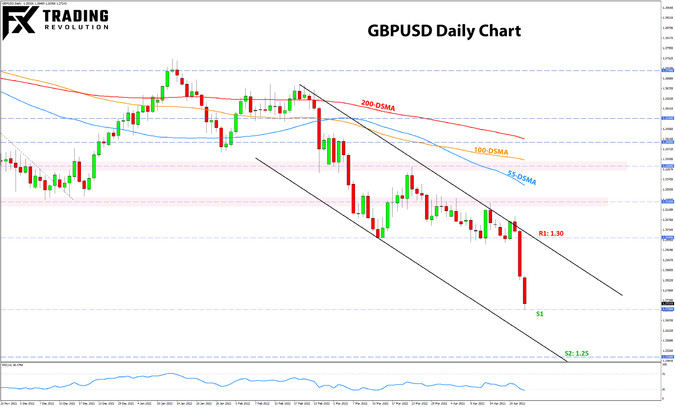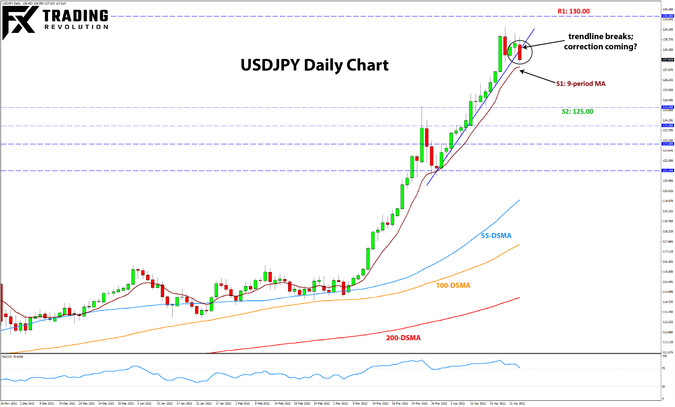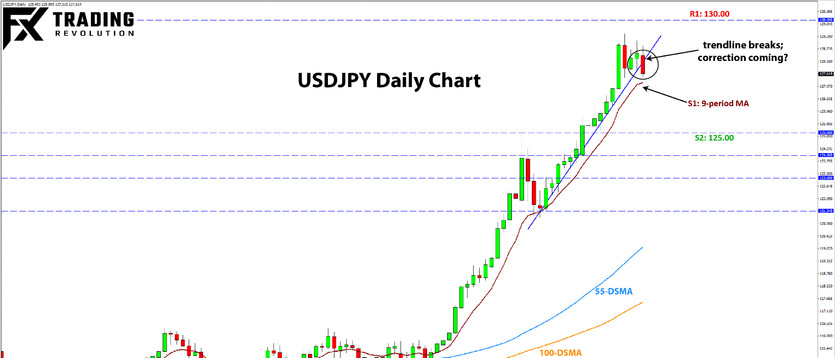USD Weekly Fundamental Outlook: Uptrend Extends; PCE Inflation & GDP Unlikely to Have a Big Market Impact
It was another strong week for the US dollar, with the DXY index now pushing firmly above 101. These are the strongest DXY levels since March 2020, when the pandemic-induced crisis triggered a severe shortage of dollars in global markets.
The past and this week are a quiet period ahead of the busy first week of May that features, among else, the Fed meeting and the Nonfarm payrolls report. Thus, without anything that can alter the longer-term Fx drivers, the markets’ focus is fixated on the divergence between the hawkish Fed and other central banks that are either less hawkish or outright dovish (e.g., BOJ). This policy divergence is and will likely continue to push the dollar higher in the coming weeks.
And unlike in the 2020 Covid crisis, when the Fed stepped in to flood the markets with dollars, which effectively killed the rally, this USD bull trend is an entirely different beast. With US inflation at record 40-year highs and the economy booming, the Fed very much welcomes USD strength. Liquidy is also not an issue today. This means that the DXY index can as well surpass the 2020 highs around 103.
The focus on the US calendar this week is on Thursday’s GDP release and Friday’s PCE inflation report. While both data pieces are important, no big surprises are expected, at least none that will alter the Fed’s path to tighten aggressively. Thus, no sizable market impact on the USD is likely from the reports.
EUR Weekly Fundamental Outlook: Euro Falls Despite Macron’s Win
The euro is down today, which perhaps is a surprise to some, considering that Macron was confirmed as French President for another 5-year term last night. But the move just shows that the market never really thought that Macron could lose this election, so very little risk premium was priced in the first place.
Instead, today’s EUR decline looks like an extension of the broader bearish trend. Eurozone economic data is not terribly bad as last week’s PMIs and today’s German Ifo showed. But the impact from the war in Ukraine can be still felt. ECB policymakers are also on the same page. President Lagarde last week talked again about the difference between inflation in the United States (broad-based) and in Europe (largely driven by rising energy costs). This very much confirms the narrative that the ECB simply won’t be able to match the Fed’s hawkishness any time soon because the outlook for the Eurozone economy is much less optimistic than for the US. The policy divergence between the ECB and others should keep downtrends in EURUSD and other EUR pairs intact.
The EUR calendar is light until Thursday and Friday when the focus will be on CPI inflation and GDP reports for the largest EU countries as well as the aggregate for the whole euro area. The inflation numbers will be of particular interest, where potential upside surprises could provide some short-term relief support to the euro. Aside from the very short-term, the bearish EUR trend is unlikely to be affected much by a single CPI report.
EURUSD Technical Analysis:
The bear trend is continuing here at the same gradual pace from the start of the month. The pair reached the 1.07 level today and is now consolidating above it. A break below looks likely.
The next support zone below will be at 1.06. This is also the area where EURUSD bottomed in 2020. However, the more important support in the current context remains 1.05, where we could see a stronger reaction.
To the upside, 1.08 would be the first resistance zone, followed by last week’s high around 1.09. 1.10, of course, remains the more important resistance zone.
GBP Weekly Fundamental Outlook: Risk Aversion Adds to the Negatives
The pound was weaker across the board last week, hit by a mix of weak economic data and worsening risk sentiment. A break of the 1.30 psychological level has likely added to the bearish momentum (more on that below).
The miss in the retail sales report last Friday initially triggered the move below 1.30, which was then aggravated by the sharp sell-off in global equity indices on the same day. GBPUSD is especially hit hard, given the pound’s correlation with risky assets and the ongoing broad USD strength. This trend likely has more fuel to run as the UK economy is set to weaken further, limiting the scope for BOE rate hikes and monetary tightening.
Add risk aversion to all GBP negatives, and you get a sharp sell-off in the currency. Thus, stock markets and general risk sentiment should remain an important focus on the radar for GBP traders over the coming weeks. The UK economic calendar is very light this week, and traders may already start to focus and speculate on the May 5 Bank of England meeting, where the risk for a dovish disappointment is growing.
GBPUSD Technical Analysis:
GBPUSD started a new bearish leg after it broke the 1.30 psychological support level last Friday. The sell-off accelerated quickly, and GBPUSD touched 1.27 earlier today.
Given this strong momentum, further downside price action looks probable, though at levels below 1.27, GBPUSD will enter oversold territory. This means that a break below 1.27 is likely, but the correction may start soon after.
Note that 1.25 is the big support area, with the wider zone defined between 1.27 and 1.25. If/when reached, some reaction in this area looks likely. The question is whether GBPUSD will actually reach the 1.25 level or bounce before that.
As a result of the steep decline, there is no notable resistance to the upside until the same psychological 1.30 zone.

JPY Weekly Fundamental Outlook: Thursday BOJ Meeting in Focus; Risks for a Yen Correction Have Risen
The yen extended the slide last week, with USDJPY reaching 20-year highs. The decline inspired more discussions about the yen from Japanese officials, and again, they mainly repeated the same message - that a weaker yen is good for the economy, but sharp declines like the current one are undesirable.
This can be interpreted to mean that the trend of JPY weakness is set to continue, but the risks for a correction in the near term have risen. The yen has weakened by more than 10% versus the dollar in less than two months. That is a steep decline, and Japanese officials may not want to see USDJPY trading above 130.00 so soon.
The Bank of Japan meets on Thursday, and this could finally be a meeting where they could cause some volatility. They will certainly talk about the recent JPY weakness and what they plan to do (or not do) about it. A lot of focus will also be on their QE and YCC policies, which are the primary reason for JPY’s decline.
The risks to bearish JPY positions are that the BOJ will announce some changes to the YCC policy. Effectively, they can curb or slow down yen weakness in this way. With the market having moved by so much already and JPY pairs heavily overbought, the risks are that we could see a big corrective reaction on any such announcement from the BOJ.
USDJPY Technical Analysis:
USDJPY reached a high of 129.40 on Wednesday and has been consolidating since then. The pair is now heavily overbought on multiple timeframes, so some consolidation is welcomed.
In this sense, traders should also watch for the risk of an oversized correction down (especially considering that stocks are falling and the BOJ meets on Thursday). As we know, markets don’t move in a straight line. So oftentimes, sharp moves in one direction can be followed by sharp corrections in the other direction. While the bull-trend remains intact, a mere 38.2% Fib retracement of the rally since early March would mean a further 400 pips downside correction (USDJPY under 124.00).
Today USDJPY has broken the rising trendline that supported the rally since April 1. This could be the first signal for the start of such a deeper correction. The short-term 9-day moving average is near, at 127.20. If that goes too, then the selling could accelerate and quickly take USDJPY to 125.00.
To the upside, 130 is the obvious level to watch. It was not reached on the last move up, but another bullish attempt may as well achieve that. How USDJPY would react in this scenario is very hard to say at this stage, and would probably depend on how the BOJ reacts (whether they accept or fight the 130.00 mark).






